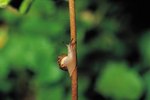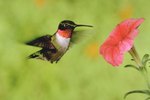
Some birds, such as snail kites and song thrushes, have special adaptations that help them capture and eat snails; other species only eat snails opportunistically. According to a 2000 issue of “Web Ecology,” many birds depend on snails as a source of dietary calcium. As snail populations are declining in many areas, some bird species are struggling to cope. Calcium deficiencies cause birds to lay thinly shelled eggs, which reduces their chances of successfully incubating the eggs to term. Birds often postpone egg deposition until they can consume enough calcium to lay high-quality eggs.
Songbirds
Many songbirds eat snails opportunistically. Bluebirds (Sialia sialis), thrushes (Catharus sp.), red-winged blackbirds (Agelaius phoeniceus), starlings (Sturnus vulgaris) and robins (Turdus migratorius) frequently eat snails if they are small enough to swallow. A few enterprising species such as song thrushes (Turdus merula) are able to eat snails that are too large to swallow by smashing the snails on rocks. These rocks—termed "thrush anvils"—are often used repeatedly; you can recognize them from the many shell fragments scattered around.
Larger Birds
Larger birds do not have difficulty swallowing snails, and frequently consume them. Blue jays (Cyanocitta cristata), crows (Corvus sp), magpies (Pica sp.), ravens (Corvus sp.) and other corvids eat snails. Hawks and owls will also eat large snails as they find them. Birds that live in aquatic habitats often hunt snails: great blue herons (Ardea herodias) and green herons (Butorides virescins) eagerly consume any they encounter while hunting the shores and shallows of marshes and wetlands. Additionally, ducks—including mallards (Anas platyrhyncos), wood ducks (Aix sponsa) and ruddy ducks (Oxyura jamaicensis)—consume snails eagerly.
Snail Specialists
Some birds specialize in hunting snails. Snail kites (Rostrhamus sociabilis), which feed almost exclusively on apple snails (Pomacea sp.), are one such example. Inhabiting tropical swamps and wetlands from South America through Central America and into parts of Florida, snail kites fly over shallow water looking for their prey. Flying at heights of up to 100 feet, snail kites swoop down and grab snails with their talons. They are able to extract the fleshy mollusks using their long and slender hooked beaks.
Snail Dispersal
Some snail species actually benefit from bird predation. In a study published in a 2011 issue of “Journal of Biogeography,” Shinichiro Wada, et al. demonstrated that snails could survive passage through a bird’s digestive system. The researchers fed land snails (Tornatellides boeningi) to two different bird species: Japanese white-eyes (Zosterops japonicus) and brown-eared bulbuls (Hypsipetes amaurotis). According to the study, 14.3 percent of the snails eaten by Japanese white-eyes survived passage through the digestive system, while 16.4 percent of the snails eaten by brown-eared bulbuls survived. The researchers suggest that bird predation plays an important role in dispersal: a snail can travel much further in the belly of a bird than it can by crawling.
References
- Journal of Biogeography: Snails Can Survive Passage Through a Bird’s Digestive System; Shinichiro Wada, et al.
- Cornell Lab of Ornithology: Snail Kite
- Animal Diversity Web: Rostrhamus sociabilis
- The Living World of Molluscs: Enemies of Terrestrial Snails
- Garden Organic: Slugs and Snails
- South Carolina Department of Natural Resources: Wildlife Management Guide: Wood Duck [PDF]
Resources
- Proceedings of the Royal Society: Host Diversity Begets Parasite Diversity: Bird Final Hosts and Trematodes in Snail Intermediate Hosts
- Cornell Lab of Ornithology: Mallard
- Outdoor Alabama: Ruddy Duck
- Ecosystem Gardening: American Robins in Your Wildlife Garden
- Web Ecology: Calcium, Snails and Birds: A Case Study [PDF]
Photo Credits
-
Stockbyte/Stockbyte/Getty Images




